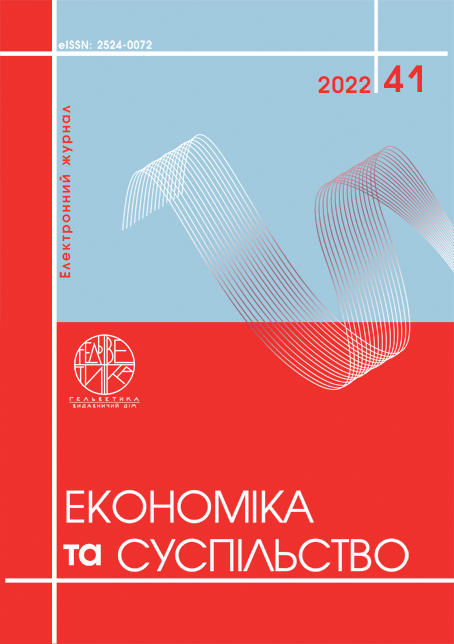EVOLUTION OF THE THEORETICAL APPROACHES TO HYSTERESIS OF DOLLARIZATION STUDIES
Abstract
Among the features of the unofficial dollarization phenomenon is the effect of dollarization hysteresis. It means the maintenance of a high level of unofficial dollarization for a long time even after the elimination of its causes and improving the general economic and political situation in the country. A synonym for this phenomenon is the well-known term “ratchet effect”. This effect complicates the effective de-dollarization policy and needs to be studied in more detail. Active studies of this phenomenon in the economic literature began in the 1990s on the basis of data from countries that experienced currency and financial crises. In particular, a large number of studies are based on empirical analysis of the experience of Latin American countries, countries with economies in transition, post-Soviet and developing countries. The article summarizes the main theoretical approaches to the study of the phenomenon of hysteresis (or the ratchet effect) of dollarization and currency substitution (use of foreign currency only in cash circulation) in scientific works during 1989-2021. Based on the analysis of empirical studies of dollarization in the countries of Latin America, transition economies and developing countries, conclusions were made regarding the main explanations of the hysteresis of dollarization and currency substitution. Most authors consider long-term devaluation expectations of economic entities and population (based on previous negative experience of the country’s economic performance) and network externalities (the choice of foreign currencies for transactions, since the foreign currencies are already widely used) to be the reasons for maintaining a high level of dollarization even after the inflation decreasing and the exchange rates stabilization. Many works also emphasize the existence of two equilibrium states of deposit dollarization – low (about 15%) and high (about 75%). When exchange rates are stable, convergence to a higher equilibrium level of dollarization begins when the 45-50% threshold is exceeded. For the Ukrainian economy, this issue is also relevant, therefore it is necessary to study in detail the hysteresis of dollarization in Ukraine and the factors affecting it.
References
Melvin, Michael and Fenske, Kurt. (1992). Dollarization and Monetary Reform: Evidence from the Cochabamba Region of Bolivia. Revista de Análisis Económico – Economic Analysis Review, Vol 7, No 1, pp. 125-138.
Melvin, Michael and Ladman, Jerry. (1991). Coca Dollars and the Dollarization of South America. Journal of Money, Credit and Banking, Vol. 23, No. 4, pp. 752-763.
Calvo, Guillermo and Végh, Carlos A. (1992). Currency Substitution in Developing Countries: An Introduction. IMF Working Paper No. 92/40.
Dornbusch, Rudiger and Reynoso, Alejandro. (1989). Financial Factors in Economic Development. NBER Working Paper No. 2889.
Dornbusch, Rudiger, Sturzenegger, Federico and Wolf, Holger. (1990). Extreme Inflation: Dynamics and Stabilization. Brooking Papers on Economic Activity, 1990, pp. 2-84.
Guidotti, Pablo and Rodriguez, Carlos. (1992). Dollarization in Latin America: Gresham’s Law in Reverse. IMF Staff Papers, Vol. 39, No. 3, pp. 518-544.
Uribe, Martin. (1997). Hysteresis in a simple model of currency substitution. Journal of Monetary Economics, Elsevier, vol. 40 (1), pp. 185-202.
Peiers, Bettina and Wrase, Jeffrey M. (1997). Dollarization hysteresis and network externalities: theory and evidence from an informal Bolivian credit market. Working Papers 97-21. Federal Reserve Bank of Philadelphia.
Honohan, Patrick and Shi, Anging. (2001). Deposit dollarization and the financial sector in emerging economies. Policy Research Working Paper Series 2748, The World Bank.
Havrylyshyn, Oleh and Beddies, Christian H. (2003). Dollarisation in the Former Soviet Union: from Hysteria to Hysteresis. Comparative Economic Studies, Palgrave Macmillan; Association for Comparative Economic Studies, vol. 45(3), pp. 329-357.
Shinkevich, Andrei and Oomes, Nienke. (2002). Dollarization Hysteresis in Russia. Economics Education and Research Consortium (EERC). January 2002.
Oomes, Nienke. (2003). Network Externalities and Dollarization Hysteresis: The Case of Russia. IMF Working Paper No. 03/96. Washington: International Monetary Fund, .
Tellería, Bernardo X. Fernández. (2007). Dollarization hysteresis, network externalities and the “past legacy” effect: the case of Bolivia. Monetaria, Centro de Estudios Monetarios Latinoamericanos, CEMLA, vol. 0(2), pp. 167-217.
Krupkina, Anna and Ponomarenko, Alexey. (2015). Deposit dollarization in emerging markets: modelling the hysteresis effect. BOFIT Discussion Papers 32/2015, Bank of Finland, Institute for Economies in Transition.
Burova, Anna; Kozlovtseva, Irina; Makhankova, Natalia and Morozov, Alexander. (2021). Dollarization, Financial Stability Risks and Monetary Policy Implementation: Exploring the Nexus. Ensayos Económicos, Central Bank of Argentina, Economic Research Department, vol. 1(77), pp. 50-71.
Us, Vuslat. (2003). Analyzing the Persistence of Currency Substitution Using a Ratchet Variable : The Turkish Case. Emerging Markets Finance and Trade, 39:4, 58-81.
Irfan, Civcir. (2010). The Long-Run Determinants of Dollarization in Turkey. EcoMod2002 330800019.
Şıklar, İlyas; Karagöl, Veysel and Şahin, Suzan. (2017). Is There Any Meaningful Ratchet Effect in the Process of Currency Substitution? Evidence from Turkey. Business and Economic Research, Macrothink Institute, vol. 7(2), pp. 146-162.
Hijazeen, Issa and Al-Assaf, Ali. (2018). Dollarization in Jordan. International Journal of Economics and Financial Issues, Econjournals, vol. 8(2), pp. 14-24.
Menon, Jayant. (2008). Cambodia's Persistent Dollarization: Causes and Policy Options. Working Papers on Regional Economic Integration 19, Asian Development Bank.
Bawa, Sani; Omotosho, Babatunde and Doguwa, Sani. (2015). Ratchet Effects in Currency Substitution: An Application to Nigeria. CBN Journal of Applied Statistics. Volume 6.
Mongardini, Joannes and Mueller, Johannes. (1999). Ratchet Effects in Currency Substitution: An Application to the Kyrgyz Republic. IMF Working Paper 99/102.
Freitas, Miguel Lebre de. (2003). Revisiting Dollarisation Hysteresis: Evidence from Bolivia, Turkey and Indonesia. NIPE Working Papers 12/2003, NIPE – Universidade do Minho.
Valev, Neven T. (2010). The hysteresis of currency substitution: Currency risk vs. network externalities. Journal of International Money and Finance, Elsevier, vol. 29(2), pp. 224-235.
Samreth, Sovannroeun. (2011). An Empirical Study on the Hysteresis of Currency Substitution in Cambodia. Journal of Asian Economics, Vol. 22, No. 6, pp. 518-527.
Idrisov, Georgy and Freinkman, Lev. (2009). Modeling the Currency Structure of Bank Deposits: Does the Ratchet Effect Matter? Working Papers 0005, Gaidar Institute for Economic Policy.


